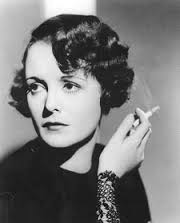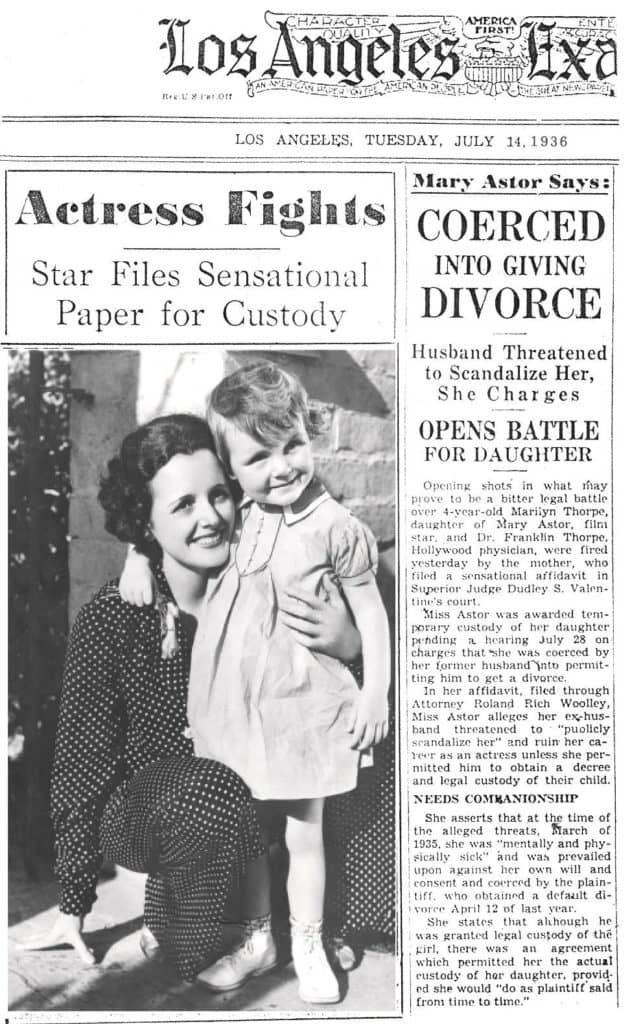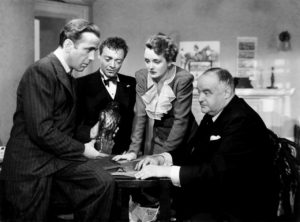Lucy La nghanke – you’d have to be into movies in a pretty unhealthily obsessive way to know that that’s the real name of the great ’30’s- ’40’s actress Mary Astor. Mary Astor is best remembered for a handful of things – playing Brigid O’Shaughnessy in The Maltese Falcon, winning an Academy award for The Great Lie, and being involved in one of the most scandalous child custody fights in Hollywood history (I’ll note that Brad-Angelina war has only just been declared).
nghanke – you’d have to be into movies in a pretty unhealthily obsessive way to know that that’s the real name of the great ’30’s- ’40’s actress Mary Astor. Mary Astor is best remembered for a handful of things – playing Brigid O’Shaughnessy in The Maltese Falcon, winning an Academy award for The Great Lie, and being involved in one of the most scandalous child custody fights in Hollywood history (I’ll note that Brad-Angelina war has only just been declared).
Mary Astor’s custody fight happened in the mid-1930’s, in the middle of the Depression and with Hollywood perhaps at its height. On the surface, it seems to have nothing in common with divorce and custody hearings today. But here the surface is just that.
The facts are these: Mary Astor married Dr. Franklyn Thorpe in June, 1931. They had a child, Marilyn, in June 1932. In late 1933, Mary, unhappy in the marriage and in her career, went to New York to work on the stage. She had an affair (torrid was the mildest word used in the tabloids of the day) with the playwright and Broadway directer, George S. Kaufman, a founding member of the Algonquin Round Table. Mary, an excellent writer (she would go on to write two bestselling memoirs and five novels), kept a well-written, fairly detailed diary.
Back in Hollywood in late 1935, Mary went back to work. In 1936 Dr. Thorpe obtained an uncontested divorce. Then he found the diary. Then he demanded custody. Then it went to trial. Then it got ugly.
The one thing to immediately take from this in the age of litigation and the Internet is pretty clear: you can hide a diary, most people probably a little bit better than Mary Astor, but you can’t hide your social media. Enough said, that’s not where I’m really going with this.
diary, most people probably a little bit better than Mary Astor, but you can’t hide your social media. Enough said, that’s not where I’m really going with this.
Dr. Thorpe claimed that Mary was an unfit mother because she had affairs. Well, probably not so much that as the fact she wrote about them and he did not do well in any of her comparisons – and she compared a lot Nevertheless, it didn’t look good for Mary – in civil court or the court of public opinion. Absent a good attorney, in 1936, Mary’s prognosis was bleak.
But, several things happened in short order. Mary retained an attorney almost as famous as her, George Simon Kaufman. He had the diary thrown out, made inadmissible. The fact that Thorpe had shared it with the gossip columnist for The New York Daily News and they added their own entries and changed others probably had a lot to do with that decision.
Perhaps just as important, Kaufman laid out all the facts. Facts like these: back when Mary was Lucy she had the stage parents from hell. She made her screen debut at 14, was under contract to a studio for $500/wk (that’s $7,000 in today’s dollars) and was basically imprisoned at home. Her parents, to be kind, never let her out of their sight. She was alloted a $5/week allowance, although, of course, she had no place to spend it. Her father, meanwhile, was physically abusive and constantly demeaned her performances.
Mary managed to. literally, escape – she fled the mansion her parents bought with her money through a carelessly left-open third floor window. At the time, 1928, she was earning $3750/wk ($53,000 … a week). She married a director in 1929, but her parents still kept a tight reign on the money. By the time she gained control of her finances in 1932 there was so little money left she had to ask for assistance from the Screen Actors guild. Her parents promptly sued her for support.
Mary’s husband, Kenneth Hawks – brother of the great director Howard Hawks – was killed in a plane crash in 1930. It was devastating. Mary had a nervous breakdown, took a leave of absence from her studio, and signed herself into inpatient treatment. By now you can guess who her doctor was – Thorpe.
 No one will know if Thorpe ever loved his wife, but there are piles of evidence that he loved her money. Immediately after the wedding he bought a yacht and opened his own practice.
No one will know if Thorpe ever loved his wife, but there are piles of evidence that he loved her money. Immediately after the wedding he bought a yacht and opened his own practice.
All this, obviously, filled in all the blanks in the case. It was enough for the judge – he awarded Mary full custody. Probably not coincidentally, her career took off. The diary disappeared sometime during the trial. It was like the Loch Ness monster of Hollywood for years, sightings were rare but hyped. In 1953, it was discovered in a safety deposit box and, by court order, it was burned.
There are, obviously, a lot of lessons here. Perhaps the most important one is this – facts are just facts until someone puts them into a narrative.
